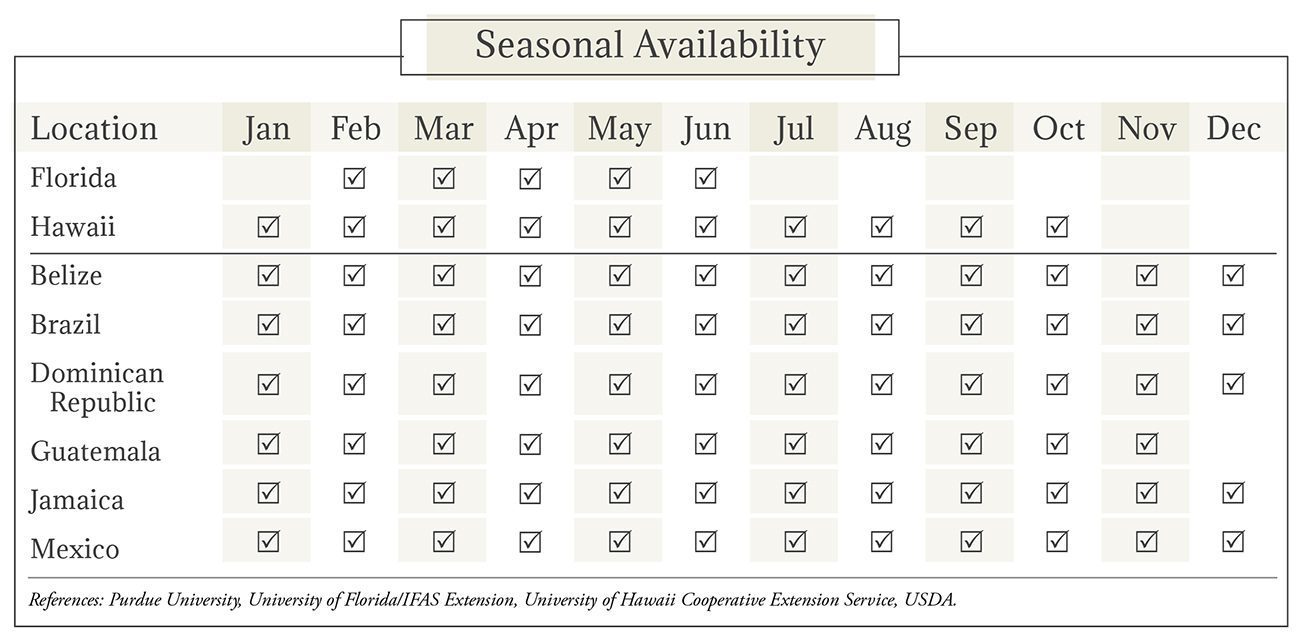Papaya Market Summary

Image: KoBoZaa/Shutterstock.com
Papaya Market Overview
Papaya (Carica papaya), reportedly called “the fruit of the angels” by Columbus, was first cultivated in Central and South America. India, Brazil, and Mexico are among the top producers, yet papaya is grown and shipped to a lesser degree from Hawaii, California, Florida, and other countries. Contrary to popular belief, papaya does not grow on a ‘tree’ but from a large herbaceous plant that can reach up to 30 feet in height. It is often called ‘pawpaw’ in other parts of the world, but should not be confused with North American asimina fruit, which has a banana-mango flavoring. Other papaya name variants include kepaya, lechosa, mamao, mamona, mikana, milikana, papaia, and he’i. Along with its succulent flesh, the fruit’s gelatinous round black seeds are edible and have a strong, peppery flavor. The fruit’s leaves are edible as well: in Southeast Asia they are cooked and eaten like spinach.
Types & Varieties of Papaya
Varieties are often classified as Hawaiian or Mexican; Solo is the most widely known Hawaiian cultivar, weighing a pound or two with yellow skin and orange or pink flesh when ripe. Mexican varieties tend to be significantly larger. Pear-shaped or round, papaya can grow up to 20 inches in length and weigh up to 20 pounds. Popular varieties in Hawaii (other than Solo) include Kapoho, Sunrise, and Waimanolo. Other worldwide variations and hybrids have included the following: Bettina, Brazilian Formosa, Burliar Long, Gold Cross, Higgins, Honey Gold, Hong Kong, Linda, Maradol, Mountain, Pusa, Red Queen, Rainbow, Santa Cruz Giant, Singapore Pink, Sunnybank, Tainung, Washington, Wilder, Yarwun Yellow, and Zapote.Cultivation of Papaya
Papaya is grown from seeds in well-drained soil, with protection from strong winds. Proper irrigation is necessary for young plants to thrive in the first year, less is needed for subsequent years. Most plants last 3 or 4 years, though yields will vary due to climate, soil type, and cultivar. Fruit is harvested when full-sized and mature, with light green coloring. Some varieties will turn yellow with ripening. Maturity is measured by latex: when it becomes less milky and more watery, fruit is ready for picking.Pests & Diseases Affecting Papaya
Papayas imported into the United States are quarantined for a number of pests including ants, aphids, leafhoppers, mealybugs, Mediterranean fruit flies, melon flies, moths, nematodes, scale, thrips, webworms, and whiteflies. Several types of mites also pose problems, including broad mites (favoring seedlings and young leaves), flat mites (feeding on fruit), Tuckerellid mites (plant trunks), as well as Texas, spider, and red mites (mature leaves). Diseases affecting plants include anthracnose, blight, internal yellowing, mosaic, necrosis, powdery mildew, ring-spot virus, root knot, many forms of rot (root, soft, stem, fruit), various types of spot (black, chocolate, dry, wet), wilt, and yellow strap leaf.



